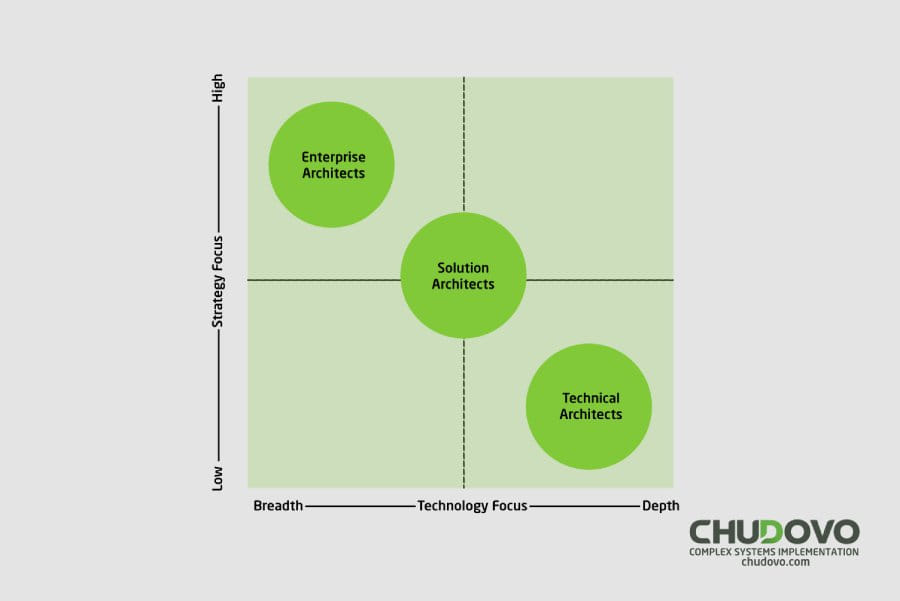What is a Solutions Architect? Role & Responsibilities
Solutions architecture is a collection of integrated technologies and applications that businesses map out to accomplish their objectives and resolve specific internal and business issues. This architecture is physical (hardware) and virtual (software), but it starts as a strategy document mapping out the requirements for enterprise software that will accomplish the organization’s objectives.
It is the responsibility of solutions architects to ensure that the applications and hardware are aligned with the specified strategy and requirements. In this guide, we’ll define who a solutions architect is and their responsibilities in an organization.
Table of content
- What is a solutions architect?
- Why do companies need a solutions architect?
- Comparing the Solutions Architect role with the Technical/Software Architect, the Enterprise Architect, and the Infrastructure Architect
- Software/Technical Architect vs. Solutions Architect
- Enterprise Architect vs. Solutions Architect
- Infrastructure Architect vs. Solutions Architect
- Intersection of the Solutions Architect role with Software, Enterprise, and Infrastructure Architect roles
- Why should you consider a career as a solutions architect?
- Training and certifications for the Solutions Architect role
- Skills and job requirements for the Solutions Architect role
- Technical requirements for the role
- Soft skills for the role
- Roles and responsibilities of a Solutions Architect
- Conclusion
Who Is A Solutions Architect?
A solutions architect is a technical strategist responsible for creating custom software solutions that help businesses achieve their goals. Solutions architects are responsible for the design, implementation, and management of enterprise-level IT solutions. They guide IT teams and ensure software solutions are built with the organization’s business objectives and objectives in mind.
Solutions architects also evaluate system architecture to ensure it is up-to-date, secure, and compliant with industry standards. To succeed in this role, it’s crucial to have a holistic understanding of business needs, as well as the technical knowledge necessary to develop and implement appropriate software and hardware technologies and programming.
Why do companies need a Solutions Architect?
Various businesses and organizations, including software and technology providers, startups, telecommunications companies, insurance companies, fintech, and other financial institutions, consult solutions architects. A Solutions Architect plays a vital role because these professionals are responsible for creating and guiding the technical vision and design of the business’s digital transformation strategy.
They provide guidance and support for their clients in their specific problem areas – such as data management, system and application development, project management, and security. Companies need them because:
- They design, develop, and implement tech solutions to meet business requirements, as well as implement them into working systems.
- They propose effective solutions within the available budget, giving practical advice on which software and systems to purchase.
- They also monitor and troubleshoot the systems, as well as provide technical expertise for internal teams.
- Well-built solution architecture helps Product and Dev teams to develop products on time, ensures that it solves the problem it was designed to solve, and fits the overall software architecture of the company.

Comparing The Solutions Architect Role With The Technical/Software Architect, the Enterprise Architect, and the Infrastructure Architect
Some other names for this role across different industries include Software Architect, IT Architect, Cloud Solutions Architect, and Enterprise Architect. Others are Network Architects, Database Architects, Software Engineering architects, Digital Solutions architects, Mobile Solutions architects, and Technical architects.
The most common roles are Technical Architect (usually interchangeable with Software Architect), Enterprise Architect, and Infrastructure Architect. Before we go further, we have to explore the subtle differences between these roles and their applications in the industry.
The intersection of the business requirements and technical requirements of the role mainly differentiates these distinctions between them. Knowing these subtle differences in how the title translates to how it’s approached will give more clarity on choosing a career in this area of software engineering.
Software/Technical Architect vs. Solutions Architect
The Software Architect focuses on all the aspects related to software engineering on a particular project, from the development of the idea to implementation, maintenance, support, and evolution as business need change. A Software or technical architect is mainly in charge of engineering problems and custom software development, rarely involved in financial and organizational issues. At the same time, a Solutions Architect has to be involved in the financial and project planning of software and hardware development.
Enterprise Architect vs. Solutions Architect
Enterprise architecture defines the strategic directions of the business architecture, including the technology needed to support that architecture.
The enterprise architect has the broadest view of the company’s current state and goals, creating a strategic plan for implementing technical changes.
Enterprise Architects focus on building complex enterprise ecosystems and solving high-level strategic issues.
The distinction between the Enterprise Architect and a Solutions Architect is more subtle here because they are both strategy-based roles. A straightforward way to understand these roles is to think of them this way: the enterprise architect defines what has to be done, while the solution architect decides how to do it.
Infrastructure Architect vs. Solutions Architect
An infrastructure architect is much like a technical architect but focuses on a corporate on-premises server or cloud systems of an organization.
They oversee the existing IT systems and networks and explore and integrate new ones, ensuring they meet all requirements regarding resilience, security, performance, availability, etc.
This means that an infrastructure Architect maintains the production side rather than software development in the corporate ecosystem. At the same time, a Solutions Architect has a high-level buy into the software development process and understands how technology intersects with business objectives.
Intersection of the Solutions Architect role with Software, Enterprise, and Infrastructure Architect roles
As solution architecture focuses more on details and technologies to address a specific business problem, it provides a channel between enterprise architecture and technical architecture.
A practical approach combines enterprise architecture activities with solutions and technical architecture activities for an integrated result.
No matter what the title is called, a solutions architect’s role is to keep the business up to date across the internet of things (IoT) space and ensure that its IT solutions are secure, scalable, and cost-effective, given the business’s long-term goals.
This role covers a bespoke range of responsibilities unique to a business’s technological needs, size, industry, and budget. In a nutshell, a solutions architect is responsible for:
- Analyzing organizational needs and creating comprehensive IT solutions.
- Designing and developing architectures for new implementations, upgrades, and integrations.
- Developing solution designs, deployment plans, and implementation processes.
- Providing technical advice to other teams and leading them in solution implementation.
- Overseeing testing and fixing errors, creating documentation, and ensuring compliance with relevant industry standards.
Essentially, a solutions architect’s job is to be a multi-tasker and a problem-solver who knows how to apply technology solutions to business objectives.

Why Consider A Career As A Solutions Architect?
Becoming a solutions architect is a promising career path based on the following reasons:
- This role is a great way to explore different aspects of software engineering (product management, Cloud infrastructure, software programming, etc.) and become an effective generalist.
- You don’t need a degree in engineering to break into Solutions Architecture. So far as there’s a foundational knowledge of coding and an interest in the field, you can develop your skills for this role and start building work experience within six months – 1 year. This also depends on your learning capacity and access to paid resources.
- This field is in constant demand in a technology-led world. Organizations will always look for professionals to help them develop, scale, and optimize their software.
- Solutions architects earn well. We ran the numbers on Glassdoor, and the average Solutions Architect in America with 1-3 years of experience can earn up to $150,000 yearly. That’s a mid to senior-level annual pay range.
Let’s dig into this role further by exploring what it takes to qualify for a career as a Solutions Architect.
Training and Certifications for the Solutions Architect role
An IT professional transitioning into a solutions architecture role will need to have extensive knowledge and experience in the areas of systems engineering, software engineering, database management, networking concepts, cloud computing, and service management. They will also need a solid understanding of various technologies, such as web services, virtualization, distributed systems, and software-defined networking.
To acquire this knowledge, IT professionals should consider industry-standard certifications such as the Solutions Architect Credential from the Cloud Credential Council or the Infrastructure Solutions Architect Certification from the Oracle Corporation. They should also pursue certifications in specific technical skills like AWS, Azure, Scrum, and DevOps.
Skills and job requirements for the Solutions Architect role
There are technical requirements and soft skills required for a solutions architect role. Let’s discuss each of them below:
Technical requirements for the role
Most job listings for solutions architects will require a degree in engineering, computer science, or other related college degrees. If you don’t have a background in STEM, don’t let this discourage you from pursuing this field.
Tech is about what you can practically do and less about what you read in college. Solutions architect skills span tech and business skills, which can both be developed and grown over time and with the application of practical, real-life solutions.
IT professionals should be grounded in the following technical skills to be considered a well rounded Solutions Architect:
Expertise and experience in several deep programming languages
Some programmers specialize in one language, but a Solutions Architect needs to be knowledgeable enough in any programming language that supports a business’s long-term strategic goals. These goals could change, which might mean a change from one language to a more effective one. So they need to know HTML, Java, JavaScript, Ruby, Python, Rust, Go, C, C++, Cobol, and others.
Have a working knowledge of product management
A good Solutions Architect should have some experience in the product development process and understand the product life cycle. Solutions architects should be good product managers to effectively understand product requirements, user stories, and customer needs.
This understanding allows them to design superior product solutions that meet these needs while ensuring that the architecture is optimized for performance, scalability, and maintainability. Additionally, a good product manager can identify areas of the architecture that may not be as effective and suggest improvements, identify risks and address them before they become issues.
Have extensive, hands-on technical software experience
A Solutions Architect must have a solid technical background in computing, data systems, and software development-including, including IT design, architecture, and implementation. They should also have a working knowledge of cloud-based solutions, such as Amazon Web Services (AWS) and Microsoft Azure, and be familiar with software engineering principles and best practices
The ability to build and implement DevOps environments using Agile methodology
The solutions architect has to be able to manage software development practices and dedicated teams in a collaborative and agile manner. This involves SCRUM, DevOps, and operational skills and a knowledge of how to use Agile methods to push efficiency.
Soft skills for the Solutions Architect role
The solutions architect works at the intersection of technology and business, so they need to be analytical and pragmatic in planning and problem-solving. They are usually practical individuals with strong interpersonal skills.
These can be categorized as soft skills needed to excel at this role, which include:
- Project management
- Problem-solving
- Team and people management
- Negotiation
- Budgeting and operations of financial systems
- Organization
- Attention to detail

Certified engineers
Convenient rates
Fast start
Profitable conditions
Agreement with
EU company
English and German
speaking engineers
Roles And Responsibilities Of A Solutions Architect
A Solutions Architect is responsible for analyzing IT system requirements and designing, planning, and overseeing the implementation of IT systems and infrastructures. They also perform other responsibilities, such as the following:
1. Analyze and evaluate complex business requirements for IT systems and develop solution components, technologies, and tools.
First, they define and document the requirements. This involves understanding the business goals and objectives and identifying the unique technology needs that must be addressed.
Next, the requirements must be validated and assessed to meet the necessary criteria.
Once the requirements have been documented and assessed, the next step is to evaluate the existing technology infrastructure to determine if it is capable of meeting the requirements and specifying new additions and updates needed to meet the set standards.
2. Create detailed system and application design documents, as well as diagrams, process flow diagrams, and other visual representations
They have to be able to use software such as Microsoft Visio or other diagramming applications to create visual representations of system designs. This also involves employing automation tools and scripts for generating diagrams.
Solutions architects must also develop detailed use case diagrams for visualizing system components and user stories and projecting their interactions. They have to create system flow diagrams to illustrate the flow of information and control between components.
3. Design, develop, and implement innovative, secure, and efficient practical solutions to meet customer needs
A Solutions Architect designs, develops, and implements innovative, secure, and efficient practical solutions to meet customer needs by considering the business objectives, data requirements, and technical capabilities. The Solutions Architect will:
- Analyze customer business needs and develop a practical solution that meets those needs.
- Maintain technical documentation, architecture diagrams, and other artifacts
- Identify potential gaps and areas of improvement in existing solutions.
4. Provide technical expertise, project management, and guidance to ensure that solutions are deployed in a timely and cost-effective manner
A Solutions Architect needs to be a good project manager because they are responsible for the overall design of the system, its integration with the existing systems, and its development. This requires them to manage all aspects of the project, plan the timeline, coordinate resources, and manage risks.
They must understand business requirements and develop technical solutions while keeping the project timeline on track. Also, sound project management skills help the Solutions Architect to deliver the project on time, on budget, and with high-quality results.
5. Research and stay current on technical advancements and new technology solutions
Technology advances happen fast, and industry-toppling changes can happen in hours. Being curious about new developments and hungry for knowledge is a vital part of success in this role.
Some ways solutions architects can stay on top of current developments in the industry include:
- Participating in online forums
- Following industry news sources
- Joining communities of other IT professionals
6. Troubleshoot system and application issues
Solutions architects are, first and foremost, IT professionals. They are uniquely positioned to ensure that planned solutions are correctly implemented and maintained by:
- Analyzing the system environment: Solutions architects should first identify the root cause of the issue by analyzing the system environment. This includes reviewing system logs and application data, diagnosing system-level errors, inspecting configuration parameters, and validating resource utilization.
- Documenting the problem: Solutions architects should document the problem thoroughly to help build an understanding of what is causing the issue. This can include tracking down system and application data, including crash reports and memory dumps.
- Developing a plan of action: Solutions architects should develop frameworks for dealing with these system and application issues and apply them as needed to maintain efficient business processes.
They should be competent in monitoring system performance, security, and availability and be able to resolve application and hardware issues as they arise.
7. Establish and maintain effective communication with stakeholders and vendors, and cross-functional internal teams
A solution architect should have strong relational skills, good at identifying areas of improvement, and be able to negotiate between the IT team and management. They should also have good relationships with IT vendors and providers interacting with the company to ensure seamless service.
Conclusion
Being a Solution Architect is a challenging but rewarding role that requires experience, strategy, and technical skills. The main focus of a solutions architect is to create cost-effective, secure, and scalable solutions for the company’s technical needs.
Individuals motivated by problem-solving, creating systems, and using technology to solve challenges, should consider a career as a solutions architect. If you want to become a solutions architect, then you should consider following the academic and career path outlined in this guide.




